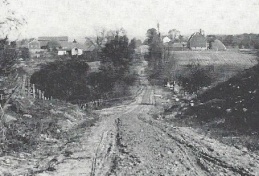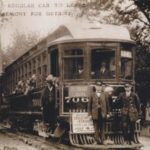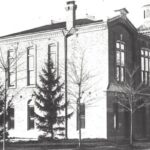
Settlers moving into Michigan had to construct their own roadways. Initially they felled trees and removed the roots forming a crude path or roadway. As more settlers came, the roadways were smoothed and packed down. However, what they were smoothing and packing was top soil, which was easily displaced. No crowning of the road surfaces or drainage ditches were constructed. Heavy loads would leave ruts even when the roadway was dry. Animals walking on the road would leave hoof prints.
When it rained, the road surface would become deeply rutted and nearly impassable. At times the wheels would sink into the mud up to the wagon’s axles causing them to tip over. It took skill for the driver to maneuver the wagon along the road without getting tossed off the wagon and into the mud. The photo above is of Sandhill Road in 1905 and even though the road surface has been crowned and drainage ditches installed, the surface would become a rutted mess after almost every rainfall. Once the roadway had dried, the surface would still be difficult to navigate because the ruts had now hardened, which made travel bumpy and difficult.
Coming out from Detroit, in numerous places the roads passed through swampy areas and the locals constructed “corduroy roads” made by laying logs side-by-side. The ride was rough and the roadway not very stable but it made for a passable route.
The most effective method of improving the roadway was to construct a plank road. A plank road consisted of stringers of oak or hemlock being semi-buried in the ground along the route and thick planks (2 to 4 inches thick) being laid across the stringers. To avoid injury to the animals, the planks were not nailed to the stringers but merely rested on the stringers. It could be considered to be a large-scale wooden sidewalk. Finally in 1844, Robert Davison of Detroit created the Plank Road Company. A plank road already existed between Detroit and Port Huron. He began at New eHBaltimore and constructed the roadway to Disco (no longer exists – about 21 Mile Road and Van Dyke), Washington Corners (now Washington), Rome (now Romeo), Almont and terminated at the old Imlay Mill located three and a half miles northwest of Imlay City.
The plank road was a toll road. In 1853 there was a school and tollgate at Hough and Van Dyke. Another tollgate was located a mile north of downtown. The toll from Almont to Detroit was about 50 cents, which was a large amount of money in those days. The nearest market for many of the farmer’s crops was Detroit. It would take about a day and a half to haul a load to Detroit. The return trip would only take a day. The difference in time was to allow the animals to rest on their way to Detroit with a heavy load.

The farmers were paid in cash for their crops, which created the opportunity for foul play on the way home. Many holdups did occur as the farmers returned through the woods.
The plank road created Almont’s first boom. Lumber and farm goods could easily reach Detroit where there was a heavy demand for these goods. The Lower Hotel (located at 209 S. Main St. – Lane-Swayze Clinic location) was often busy and the saloons did a brick business.
After the Civil War, the counties and townships made a concerted effort to improve the roads and drainage of their territories. By 1869, quality free, public gravel roads had been constructed and the plank road was replaced. In 1925 when the village was installing the sewer system, remnants of the plank road were found about 30 inches below the surface of the ground




